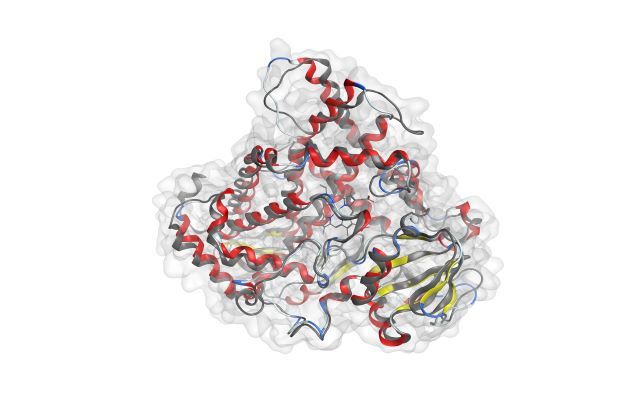Computational protein design and protein structure prediction speed up day-to-day research

The protein Cytochrome P450 from soy is involved in the degradation of various chemicals. The AI prediction from AlphaFold2 is shown in gray and the experimentally determined structure in color.
On December 10, the Royal Swedish Academy of Sciences will award this year’s Nobel Prizes in Stockholm, Sweden. The prizes for chemistry this year are all about proteins, considered the building blocks of life. David Baker (University of Washington, Seattle, USA; Howard Hughes Medical Institute, USA) who is awarded with one half of the Nobel Prize, succeeded in building entirely new proteins with the help of the computer software Rosetta. Demis Hassabis and John Jumper (both Google DeepMind, London, United Kingdom) are jointly awarded with the other half of the Nobel Prize for the development of AlphaFold2, an artificial intelligence (AI) model that predicts proteins’ complex structures.
Both discoveries hold enormous potential for BASF, where understanding protein structure has been fundamental for developing new products for decades. With the help of new technologies like Rosetta and AlphaFold2 researchers can now better predict, design and optimize for example new plant traits and crop protection products – potentially faster and with even better efficacy than with conventional protein structure prediction tools. “It can take decades to develop a new trait that makes crops resistant to pests, or to create a new chemistry that controls diseases, pests or weeds. Protein research is critical to trait and crop protection R&D, and we are already leveraging these new AI tools to accelerate the development of effective solutions for farmers and our food supply,” says Dr. Jürgen Huff, Senior Vice President Global R&D and Regulatory at BASF Agricultural Solutions. “As an innovation driven company benefitting from their work, we congratulate the laureates for their awards”.
The possibility to design new protein sequences after having an accurate three-dimensional structure streamlines BASF’s protein engineering and design pipeline. “Being able to predict protein structure enables the early adoption of several computational tools for protein modelling at the beginning of a research project,” says Dr. Stefan Seemayer, Team lead for computational protein engineering at BASF. “We can calculate thousands of hypotheses, for example for the most effective trait to confer resistance to a pest, and select high-quality designs from the generated ones, reducing our testing efforts,” he adds.
The code for Rosetta is publicly available, so a global research community has continued to develop the software since its publication in 2003, finding new areas of application. The Nobel Committee also acknowledged that AlphaFold2 is being used by more than two million people from 190 countries.
Subscribe to our newsletter & stay updated.